�
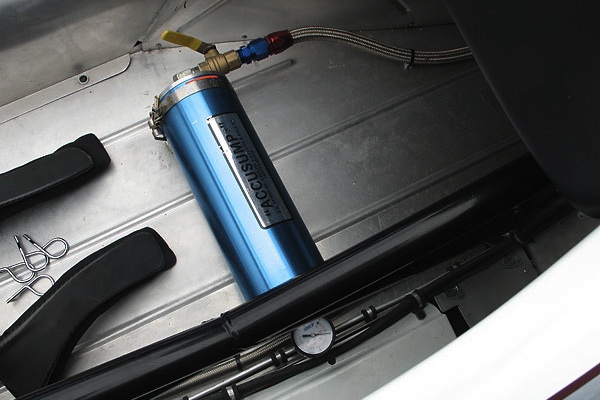
�
Keeping your Bearings
�An introduction to oil accumulators and their installation.
� as published in BritishV8 Magazine, Volume XVIII Issue 1, December 2010� �� by: Bill Young�
�
�
With the recent development of BritishRaceCar.com as a sister website to BritishV8, we're beginning to�
see a few oil accumulator systems in detailed close-up photographs. These systems are popular on�
road racing sportscars, but are also quite useful on the street because they can help extend the�
life of the lower end bearings in your engine. �
�
There are a couple of different types of systems in common use. The most basic oil accumulators are�
gravity assisted. Their sealed tanks must be mounted vertically where oil can be stored and�
returned to the engine when needed. A second and more versatile type of oil accumulator uses�
pressurized air. These can be mounted in any orientation. Both type of systems are plumbed in a�
similar manner, it's just the ability of the later piston type cylinders to be mounted in a variety�
of positions that makes that system more versatile.�
�
Piston type systems came into use in the early 1970s and were first patented in 1976. In the early�
1980s Canton Racing Products acquired the patent rights from the original owner and set about making�
modifications and improvements to the end caps and seals to improve strength, safety, and�
serviceability. The brand name "Accusump" is now almost generic for this type of system.�
�
�
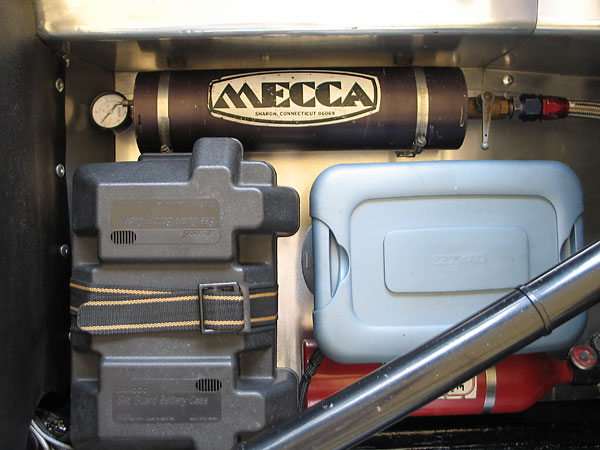
�
Accusump isn't the only name you'll find on oil accumulators when you visit the track or the
�
performance parts store. This older Mecca oil accumulator is used on Kent Prather's famous MGA.
�
Mecca was bought out by Canton Racing Products and Mecca's products were relabeled Accusump.
�
Moroso manufactures both gravity and piston type oil accumulators. Their piston-type products
�
vary slightly in design from Canton's, but the basic function and plumbing are the same.
�
How Oil Accumulators Work
��
The basic idea of these systems is to store a quantity of oil under pressure and to release�
it to flow into the engine when the oil pressure drops below the internal pressure in�
the accumulator. To prevent a loss of pressure when the engine is shut off, a valve (either�
manual or electric) is installed in-line to block the flow at those times. When the valve�
is opened and the engine is off, oil flows out of the accumulator and through the lines to�
the engine. You don't want oil to flow back into the pump and pan so a one-way check valve�
is installed to direct the pressurized oil into the engine oil galleries.�
�
�
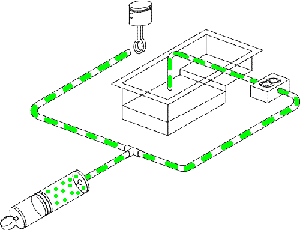 �
�
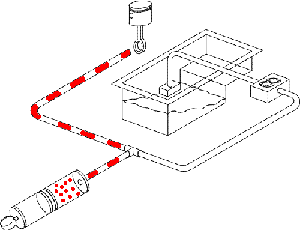
�
Charging and discharging schematic diagrams (courtesy of Canton Racing Products).
�
�
In recent years, oil accumulator systems have become popular as an aid to turbocharger cooldown.�
The accumulator system releases oil into turbo bearings after engine shutdown. It's conceivable�
for a turbo motor to actually run two separate accumulators, one for engine bearings and one for�
the turbo. A turbo oiler would necessarily be plumbed differently and a shut-off valve wouldn't�
be needed because the turbo's oil needs are after engine shut down. �
�
Many, many race cars today run oil accumulators, which is one reason that you often hear a car�
revving in the pits just prior to shut down after a track session. The driver is getting�
the oil pressure up with the engine rpm and then closing the valve to the accumulator in�
preparation for the next start cycle. An additional benefit of these systems is that while�
the car is running on the track, if the engine begins to lose oil pressure due to a low level�
in the sump (due for example to high cornering forces), the oil in the accumulator will flow�
into the engine and protect the lower end until the oil pump can regain pressure and refill�
the accumulator. �
�
Most racers mount the accumulator in the driver's compartment and use a manual ball valve�
to open and close the accumulator. Cable operated valves are sometimes used for installations�
where the plumbing is out of reach. Electrically operated solenoid valves are popular with�
some racers too, but they're best suited for street driven cars. They can either be wired into�
a separate switch, or else through a relay actuated by the ignition switch. When actuated by�
the ignition switch, a secondary manual "maintenance" switch should be mounted in the system�
to prevent pressure loss when the ignition switch might be turned on for other reasons besides�
starting the car. �
�
Plumbing Installation
��
Perhaps the easiest way to install an accumulator system is to use a sandwich plate such�
as used to plumb in a remote oil filter or oil cooler. Most of these systems are plumbed�
in with 1/2" ID hose (-8 AN) just like most remote filters and oil coolers, so tapping�
into such an existing system would be fairly easy. By contrast, finding a suitable�
large oil port on most engines other than at the oil filter mounting is difficult.�
�
�
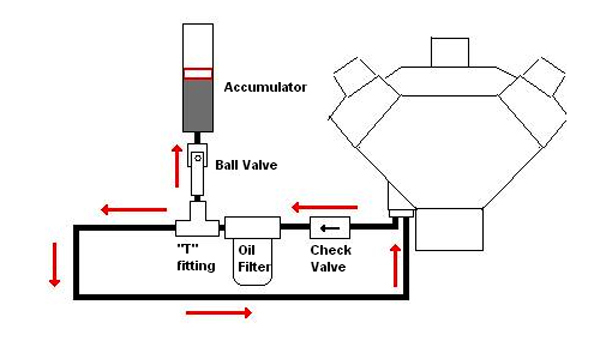
�
The basic installation is by using a "T" fitting in the pressure line and a one-way check
�
valve to prevent oil from flowing backward into the pump outlet. (Figure: Bill Young.)
�
�
Enjoying this article? Our magazine is funded through the generous support of readers like you!
�
To contribute to our operating budget, please click here and follow the instructions.
�
(Suggested contribution is twenty bucks per year. Feel free to give more!)
�
�
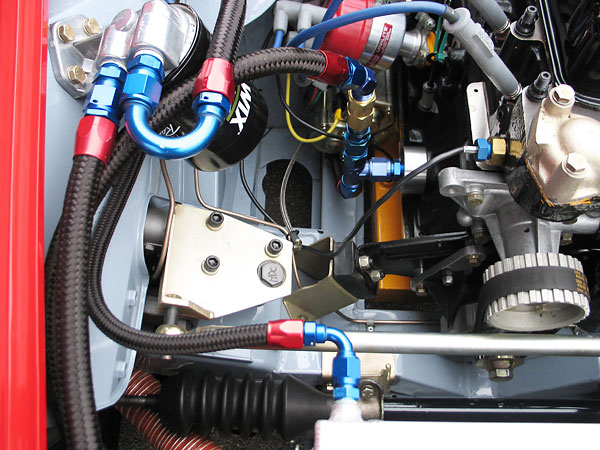
�
Here is a close-up photo of John McCue's MG Midget racecar�
showing the T-fitting for the
�
oil accumulator as well as the check valve mounted just after the oil filter assembly.
�
The accumulator is mounted in the driver's compartment.
�
�
If you're not running a remote oil filter or oil cooler, then looping off a "sandwich plate"�
with the T fitting and check valve would also be very effective. These are available from�
a variety of sources like Trans Dapt, which manufactures all types of oil cooler and remote�
filter mounts and accessories. �
�
Example Installations
��
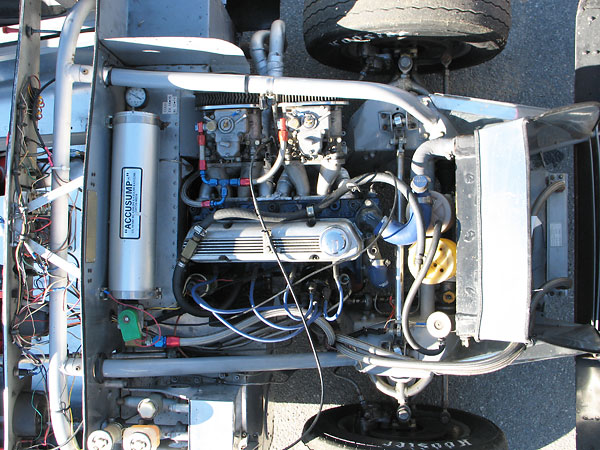
�
On Vic Schuster's Turner MkIII racecar,�
the oil accumulator is mounted in the engine compartment and operated by an
�
electric solenoid valve. This would be the most common type of installation in a street-driven car.
�
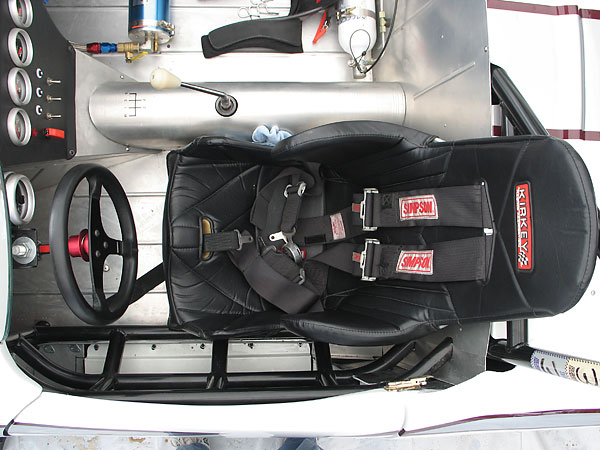
�
On Bill Thumel's Elva Courier racecar,�
the oil accumulator is mounted in the cockpit and
�
operated by a manual valve on the tank. This is the most common installation on racecars.
�
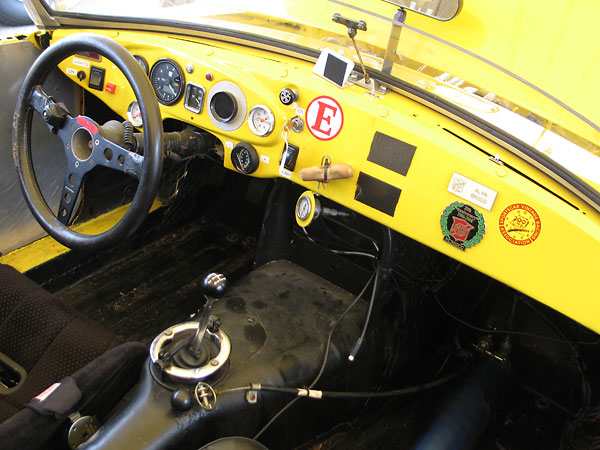
�
The B-Stingers' MGB racecar uses a cable operated valve. In this photo you can see the cable
�
just to the right of the shifter and fitted with a safety pin to prevent inadvertent operation.�
�
�
Disclaimer: This page was researched and written by Bill Young. Views expressed �
are those of the author, and are provided without warranty or guarantee. Apply at your �
own risk.�
�
Photographs by Curtis Jacobson for BritishRaceCar.com and BritishV8.org. All rights reserved.�
�
BritishV8 wishes to gratefully acknowledge Canton Racing Products' kind permission to republish�
their charging and discharging schematic diagrams (above). �
�

